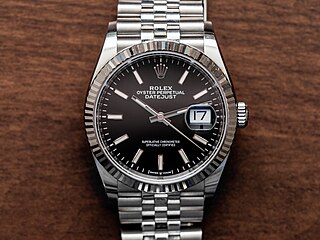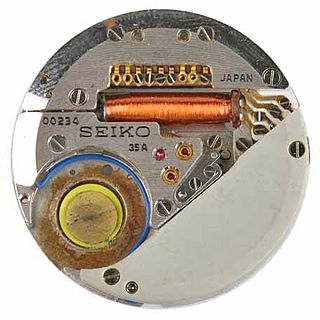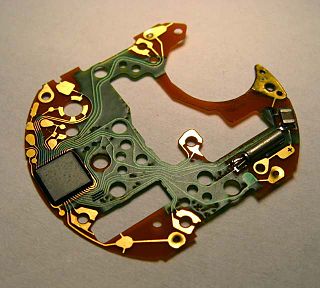
A watch is a portable timepiece intended to be carried or worn by a person. It is designed to keep a consistent movement despite the motions caused by the person's activities. A wristwatch is designed to be worn around the wrist, attached by a watch strap or other type of bracelet, including metal bands, leather straps, or any other kind of bracelet. A pocket watch is designed for a person to carry in a pocket, often attached to a chain.

Rolex SA is a Swiss watch designer and manufacturer based in Geneva, Switzerland. Founded in 1905 as Wilsdorf and Davis by Hans Wilsdorf and Alfred Davis in London, the company registered Rolex as the brand name of its watches in 1908 and became Rolex Watch Co. Ltd. in 1915. After World War I, the company moved its base of operations to Geneva because of the unfavorable economy in the United Kingdom. In 1920, Hans Wilsdorf registered Montres Rolex SA in Geneva as the new company name ; it later became Rolex SA. Since 1960, the company has been owned by the Hans Wilsdorf Foundation, a private family trust.

Omega SA is a Swiss luxury watchmaker based in Biel/Bienne, Switzerland. Founded by Louis Brandt in La Chaux-de-Fonds in 1903, the company formerly operated as La Generale Watch Co. until incorporating the name Omega in 1903, becoming Louis Brandt et Frère-Omega Watch & Co. In 1984, the company officially changed its name to Omega SA and opened its museum in Biel/Bienne to the public. Omega is a subsidiary of The Swatch Group.

Patek Philippe SA is a Swiss luxury watch and clock manufacturer, located in the Canton of Geneva and the Vallée de Joux. Established in 1839, it is named after two of its founders, Antoni Patek and Adrien Philippe. Since 1932, the company has been owned by the Stern family in Switzerland and remains the last family-owned independent watch manufacturer in Geneva. Patek Philippe is one of the oldest watch manufacturers in the world with an uninterrupted watchmaking history since its founding. It designs and manufactures timepieces as well as movements, including some of the most complicated mechanical watches. The company maintains over 400 retail locations globally and over a dozen distribution centers across Asia, Europe, North America, and Oceania. In 2001, it opened the Patek Philippe Museum in Geneva.

Vacheron Constantin SA is a Swiss luxury watch and clock manufacturer founded in 1755. Since 1996, it has been a subsidiary of the Swiss Richemont Group. Vacheron Constantin is one of the oldest watch manufacturers in the world with an uninterrupted watchmaking history since its foundation in 1755. It employs around 1,200 people worldwide as of 2018, most of whom are based in the company's manufacturing plants in the Canton of Geneva and Vallée de Joux in Switzerland.

In horology, a complication is any feature of a timepiece beyond the display of hours, minutes and seconds. A timepiece indicating only hours, minutes and seconds is known as a simple movement. Common complications include date or day-of-the-week indicators, alarms, chronographs (stopwatches), and automatic winding mechanisms. Complications may be found in any clock, but they are most notable in mechanical watches where the small size makes them difficult to design and assemble. A typical date-display chronograph may have up to 250 parts, while a particularly complex watch may have a thousand or more parts. Watches with several complications are referred to as grandes complications.

Compagnie des Montres Longines, Francillon S.A., or simply Longines, is a Swiss luxury watchmaker based in Saint-Imier, Switzerland. Founded by Auguste Agassiz in 1832, the company has been a subsidiary of the Swiss Swatch Group and its predecessors since 1983. Its winged hourglass logo, registered in 1889, is the oldest unchanged active trademark registered with WIPO.

Audemars Piguet Holding SA is a Swiss manufacturer of ultra luxury watches, headquartered in Le Brassus, Switzerland. The company was founded by Jules Louis Audemars and Edward Auguste Piguet in the Vallée de Joux in 1875, acquiring the name Audemars Piguet & Cie in 1881. The company has been family-owned since its founding.

The history of watches began in 16th-century Europe, where watches evolved from portable spring-driven clocks, which first appeared in the 15th century.

The Rolex Oyster Perpetual Datejust is a self-winding chronometer manufactured by Rolex. Launched in 1945, the Datejust was the first self-winding chronometer wristwatch to indicate the date in a window on the dial. Today, it is available in a variety of sizes from 28mm to 41mm, in stainless steel, two-tone gold, and solid gold versions.

The quartz crisis (Swiss) or quartz revolution was the upheaval in the watchmaking industry caused by the advent of quartz watches in the 1970s and early 1980s, that largely replaced mechanical watches around the world. It caused a significant decline of the Swiss watchmaking industry, which chose to remain focused on traditional mechanical watches, while the majority of the world's watch production shifted to Japanese companies such as Seiko, Citizen and Casio which embraced the new electronic technology.

Gérald Charles Genta was a Swiss watchmaker and artist. He is known for his eponymous lines of timepieces, such as Gerald Genta and Gerald Charles, as well as his design work with other high-end watch manufacturers, including IWC, Omega, Universal Genève, Patek Philippe and Audemars Piguet. Genta created the Patek Phillipe Nautilus and the Audemars Piguet Royal Oak, to date, the best-selling models of both houses. He is regarded as one of the most influential people in the history of horology.
Universal Genève SA is a Swiss luxury watch company, founded in 1894 as Universal Watch. It is a subsidiary of Breitling SA. Since its beginnings, the company has produced complete watches with in-house movements. Along with neighboring Geneva companies Audemars Piguet, Girard-Perregaux, Patek Philippe and Rolex, Universal is internationally regarded for its style of craftsmanship as a manufacture d'horlogerie. Universal Genève is known for creating the first-ever chronograph in 1917.

Quartz clocks and quartz watches are timepieces that use an electronic oscillator regulated by a quartz crystal to keep time. This crystal oscillator creates a signal with very precise frequency, so that quartz clocks and watches are at least an order of magnitude more accurate than mechanical clocks. Generally, some form of digital logic counts the cycles of this signal and provides a numerical time display, usually in units of hours, minutes, and seconds.
Antiquorum is an auctioneer of modern and vintage timepieces. Established in Geneva in 1974, Antiquorum was the first auction house to auction fine watches over the Internet in the 1990s.

The Omega Electroquartz was introduced in 1969 as the first production Swiss quartz watch. It was the collaboration of 20 Swiss watch companies and the movement was utilised by Rolex, Patek Phillipe and Omega amongst others. The Beta 21 movement used in the Electroquartz was accurate to 5 seconds per month, far better than any automatic or manual wind movement of the day.
The Patek Philippe Henry Graves Supercomplication is one of the most complicated mechanical pocket watches ever created. The 18-karat gold watch has 24 complications and was assembled by Patek Philippe. It was named after banker Henry Graves Jr. who supposedly commissioned it out of his desire to outdo the Grande Complication pocketwatch of American automaker James Ward Packard. The two were both at the top of the watch collecting world, regularly commissioning innovative new timepieces.
The Vacheron Constantin Reference 57260 is a single highly complicated mechanical pocket watch displaying the Gregorian, Judaic, and lunar calendars featuring 57 complications. The watch was assembled by Vacheron Constantin and introduced in 2015. The company claims that it is the most complicated mechanical pocket watch ever created, followed up by Patek Philippe Calibre 89 assembled in 1989 and featuring 33 complications. The Reference 57260 took eight years to assemble. The watch has 2,826 parts and 31 hands, weighs 957 grams and spans 98 mm.

A Boule de Genève is a type of pendant watch in the shape of a small ball or sphere originating from Geneva, (Switzerland). The dial is usually at the bottom of the sphere facing the floor, at the opposite side of the jump ring on the upper part of the sphere, although there are examples with a front view face. Usually, they were arabic numeral dials, sometimes Roman, and from the 1950s different types of hour markers were also used. This objet de vertu frequently came with a matching brooch, chain or chatelaine.















